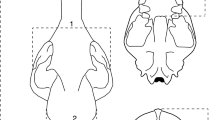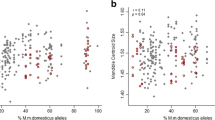Abstract
Anatomical measurements, cytological information, and a general physical description of two gibbon (Hylobates muelleri abbotti) Xsiamang (Symphalangus syndactylus)hybrid apes are presented. The characteristics of the hybrids are compared with those of the parents and other members of the parental species. These hybrids are the only known crosses between genetically distinct ape species. The hybrids displayed a mosaic of gibbon and siamang characteristics. The first hybrid had the coloring and, in general, the more cumbersome body proportions of the siamang. She lacked the siamang throat sac and like the gibbon, developed ischial callosities at an early age. The second hybrid, which died at 5 months, generally resembled the siamang. She had a dark coat, had no face ring, and did not develop ischial callosities. The conclusion of the paper examines genetic influence on morphology and behavior as illustrated by the study of this ape. Finally, the impact of this birth on current cytogenetic and evolutionary theories is discussed.
Similar content being viewed by others
References
Chiarelli, A. B. (1972). The karyotypes of the gibbons. In Rumbaugh, D. M. (ed.),The Gibbon and the Siamang, Vol. 1, Karger, Basel.
Chiarelli, A. B. (1972). The study of chromosomes. In Chiarelli, A. B. (ed.),Perspectives in Primate Biology, Plenum, New York.
Chivers, D. J. (1972). The siamang and the gibbon in the Maylay Peninsula. In Rumbaugh, D. M. (ed.),The Gibbon and the Siamang, Vol. 1, Karger, Basel.
Chivers, D. J. (1974). The siamang in Malaya: A field study of a primate in a tropical rain forest.Contrib. Primatology, Vol. 4, Karger, Basel.
Chivers, D. J. (1977). The lesser apes. In Prince Rainier and Bourne, G. H. (eds.),Primate Conservation, Academic Press, New York.
Chivers, D. J., and Gittins, S. P. (1978). Diagnostic features of gibbon species.Int. Zoo Yearbook 18: 157–164.
Ellefson, J. O. (1974). A natural history of gibbons in the Malay Peninsula. In Rumbaugh, D. M. (ed.),The Gibbon and the Siamang, Vol. 3, Karger, Basel.
Fontaine, P. A. (1968). Birth of four species of apes at Dallas Zoo.Int. Zoo Yearbook 8: 115–118.
Fooden, J. (1969). Color-phase in gibbons.Evolution 23: 627–644.
Frisch, J. E. (1973). The hylobatid dentition. In Rumbaugh, D. M. (ed.),The siamang and the gibbon, Vol. 2, Karger, Basel.
Groves, C. P. (1971). Geographic and individual variation in Bomean gibbons, with remarks on the systematics of the subgenusHylobates.Folia Primatol. 14: 139–153.
Groves, C. P. (1972). Systematics and phylogeny of gibbons. In Rumbaugh, D. M. (ed.),The Gibbon and the Siamang, Vol. 1, Karger, Basel.
Hershkovitz, P. (1968). Metachromism or the principle of evolutionary change in mammalian tegumentary colour.Evolution 22: 556–575.
Marshall, J. T., and Marshall, D. R. (1976). Gibbons and their territorial songs.Science 193: 235–237.
Miller, G. S. (1933). The classification of the gibbons.J. Mammalia 14: 158–159.
Myers, R. H., and Shafer, D. A. (1979). Hybrid ape offspring of a mating of gibbon and siamang.Science 205: 308–310.
Napier, N. R., and Napier, P. H.A Handbook of Living Primates, Academic Press, London.
Rumbaugh, D. M. (1967). Alvila-San Diego Zoo’s captive-born gorilla.Int. Zoo Yearbook 7: 9: 98–107.
Rumbaugh, D. M., Wolkin, J. R., Wilkerson, B. J., and Myers, R. H. (1976). A hybrid ape (Hylogates lar moloch XSymphalangus syndactylus).Lab. Primate Newslett. 15: 32.
Sasaki, T. (1962). Hand-rearing a baby gibbon,Hylobates lar.Int. Zoo Yearbook 4: 289.
Schultz, A. H. (1929). The technique of measuring the outer body of human fetuses and of primates in general.Contrib. Embryol. 20: 213–257.
Schultz, A. H. (1931). The density of hair in primates.Human Biol. 3: 303–321.
Schultz, A. H. (1933). Observations on the growth, classification and evolutionary specialization of gibbons and siamangs.Human. Biol. 5: 385–428.
Schultz, A. H. (1944). Age changes and variability in gibbons: A morphological study on a population sample of a man-like ape.Am. J. Phys. anthropol. 2: 1–129.
Schultz, A. H. (1973). The skeleton of theHylobatidae and other observations of their morphology. In Rumbaugh, D. M. (ed.),The Gibbon and the Siamang, Vol. 2, Karger, Basel.
Wolkin, J. R. (1977). Structural and behavioral characteristics of a young hybrid ape (Hylobates lar moloch X Symphalangus syndactylus), unpublished thesis, Georgia State University, Atlanta.
Author information
Authors and Affiliations
Rights and permissions
About this article
Cite this article
Wolkin, J.R., Myers, R.H. Characteristics of a Gibbon-Siamang hybrid ape. Int J Primatol 1, 203–221 (1980). https://doi.org/10.1007/BF02692272
Received:
Revised:
Issue Date:
DOI: https://doi.org/10.1007/BF02692272




